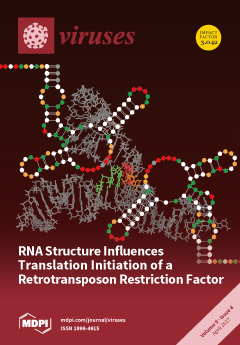Dendrolimus punctatus cypovirus (DpCPV) is an important pathogen of
D. punctatus, but little is known about the mechanisms of DpCPV infection. Here, we investigated the effects of VP3, VP4 and VP5 structural proteins on the viral invasion. Both the C-terminal of VP3
[...] Read more.
Dendrolimus punctatus cypovirus (DpCPV) is an important pathogen of
D. punctatus, but little is known about the mechanisms of DpCPV infection. Here, we investigated the effects of VP3, VP4 and VP5 structural proteins on the viral invasion. Both the C-terminal of VP3 (methyltransferase (MTase) domain) and VP4 (A-spike) bound to
Spodoptera exigua midgut brush border membrane vesicles (BBMVs) in a dose-dependent manner, and the binding was inhibited by purified DpCPV virions. Importantly, anti-MTase and anti-VP4 antibodies inhibited viral binding to
S. exigua BBMVs. Using far-Western blots, a 65 kDa protein in
Bombyx mori BBMVs, identified as alkaline phosphatase protein (
BmALP) by mass spectrometry, specifically interacted with DpCPV MTase. The interaction between MTase and
BmALP was verified by co-immunoprecipitation in vitro. Pretreatment of
B. mori BBMVs with an anti-ALP antibody or incubation of DpCPV virions with prokaryotically expressed
BmALP reduced viral attachment. Additionally,
BmALP inhibited DpCPV infection in
S. exigua larvae. Our data provide evidence that the MTase domain and A-spike function as viral attachment proteins during the DpCPV infection process, and ALP is the ligand that interacts with DpCPV via the MTase domain. These results augment our understanding of the mechanisms used by cypoviruses to enter their hosts.
Full article






